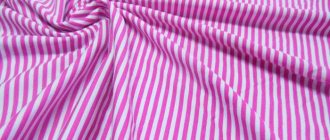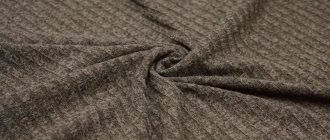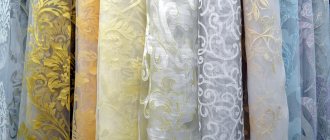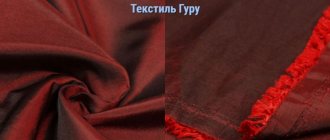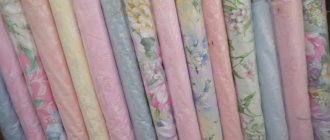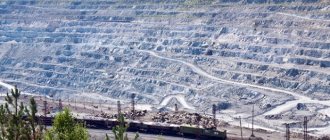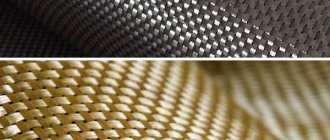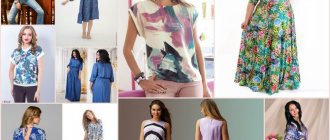How Lycra was invented
This universal material was developed by American chemical scientists in 1958. 5 years later (in 1963), Japanese scientists became interested in lycra and began its large-scale production. A couple of years later, the fabric gained popularity in Europe, and in 1970 it appeared in Russia.
Initially, American scientists set themselves the goal of creating lycra material, ideal for making belts and corsets. The fashion for such corrective products gradually faded away, and the fabric itself did not provide the required density. To prevent the idea from being a failure, in the 60s lycra became the basis for elastic (nylon) stockings. Later, the range of its use in light industry only expanded.
Helpful information:
What kind of fabric is poplin?
What kind of fabric is percale?
History of fabric
Scientists have always worked to improve and create new versions of fabrics made from synthetic fibers. Thanks to many years of work, in 1958, scientists from the USA created a technology for the production of lycra, which, in fact, changed the entire textile industry. Within 5 years it was widely used, and Japan began to become interested in the technology; in 1965 it became in demand throughout Europe, and after another 5 years it began to be produced in Russia.
It is worth noting that lycra gained such popularity completely by accident. The creators initially did not set themselves the task of inventing something that would change the world of textiles. The original purpose of creating Lycra was to create comfortable medical corsets and shapewear.
Tencel: what kind of fabric is it, description, properties and reviews
What is most interesting is that the fabric never became the basis for corsets and shapewear; instead, it was widely used in the creation of elastic nylon stockings and tights.
Over time, the popularity of this polymer only increased and soon it began to be used in a wide variety of fields. This is how the famous “mirror” leggings, elastic sportswear for aerobics and many other practical and wear-resistant items appeared. Today, the polymer is used in a variety of areas of the textile industry; the polyurethane component is used as an additive in knitted, cotton, and openwork items.
Production of lycra threads
When asked what Lycra is, the first thing that comes to mind is a synthetic material. It is made in four ways.
Brief description of each:
- Chemical . During chemical reactions, liquid polyurethane interacts with macrodisocyanate, resulting in the formation of new fibers - lycra.
- Wet . Polyurethane fibers are first boiled, then tightly wound onto a special reel and dried for 72 hours in a heat chamber at a temperature of 120 degrees.
- Dry . Unlike the previous method, polyurethane fibers are not wetted with boiling water before winding onto bobbins, but are carefully treated with special oil.
- Polymer extrusion . A viscous polyurethane solution is squeezed out through special holes, resulting in the formation of synthetic fibers.
Any of the stated methods produces fibers with the same technical characteristics . Only the time and financial costs for producing the material change.
Application of Lycra
Outfits made from fabrics with lycra do not cause much trouble for their owners. The following are sewn from materials with synthetic threads:
- men's shirts that are easy to iron;
- women's underwear (lace, slimming, stretch);
- hosiery;
- jeans and other trousers that are very tight;
- medical products (bandages, fixatives);
- sportswear that should completely fit the figure;
- tight dresses.
Material properties
Elastane is rarely used as an independent fabric; it is more often found in combination with other threads to improve the technical performance of the latter. Its popularity is growing, which is explained by the following properties of the material:
- Marking . Polyurethane fibers do not get dirty. Dirt does not get clogged into the structure of the fabric, but remains only on the surface. If you shake the product, not a trace will remain.
- Comfort . The fabric is thin, light and pleasant to the touch, endowed with “breathable” properties.
- Elasticity . Polyurethane threads stretch 8 times, and the fabric to which they are added does not lose its presentation when frequently stretched.
- Durability . Lycra increases the shelf life of fabric with its addition by almost 2 times.
- Density _ This indicator varies between 1.1-1.3 g/cm³, which provides a “stretch” effect.
- Resistance to external influences. Lycra does not fade in the sun, retains its integrity in salt water, etc.
- Practicality . The fabric does not wrinkle, does not deform after repeated washing, lasts a long time, and does not require special care for the product.
- Good drape . The material produces soft, beautiful and uniform assemblies.
Types of fabric
Products made from Lycra are rare; usually the fibers are added to other fabrics to change the properties of the latter. What materials is elastane used in:
Viscose
To give it elasticity and strength, add 5% lycra
Cotton
Cotton products combined with elastane become more elastic, less deformable and more durable
Knitwear
Elastane fiber makes it elastic, strong, durable
Footer
Adding lycra will give less deformability, elasticity and protect against the negative influence of the external environment.
Combination with other fabrics
Lycra in the composition of various materials is more often found as an additive, rarely used as a monofilament. The advantages include eliminating shortcomings and improving the quality of the latter. Having determined the difference, the buyer will always look at the label and study the composition of the material of the item of clothing he likes.
Lycra with cotton fabrics
The fabric, which combines cotton with lycra, retains its shape for a long time, stretches well, wrinkles less and has excellent air permeability. According to its properties, the material is breathable, pleasant to the body, and has a long service life.
Footer also goes well with lycra. The material itself is light, weightless, and breathable. The combination of footer with lycra makes it denser and helps maintain the shape of the product after repeated washing and natural drying.
Lycra with jersey
Knitwear is more often used for sewing children's and sportswear. The material is light, pleasant to the body, stretches and breathes. In combination with lycra, knitwear becomes more elastic and dense, and is less deformed. When 5% elastane is added to the ribana, it effectively fits the figure and stretches to the required size.
Lycra with synthetics
Viscose is a lightweight, breathable material, soft and pleasant to the touch. To increase its strength and elasticity, polyurethane threads are added to the composition, but not more than 5% of the total amount of synthetic fibers. If this indicator is exceeded, the fabric becomes rigid and the breathability is impaired.
Application area
Elastic fibers are most often added in a certain percentage to the composition of other materials. Just 2% Lycra is enough to completely change the properties of the material. It will become more durable, elastic and comfortable. The higher the percentage of lycra in the composition, the better the product will stretch. Up to 30% elastane is added to swimsuits, up to 50% to tights, and 2-5% to suits and other casual clothing. Detailed description and names of costume materials here.
The properties of lycra are widely used in the manufacture of bandages, shapewear and compression garments for medical purposes.
Care instructions
To ensure that Lycra clothing can be worn longer without loss of color and original appearance, follow these recommendations for caring for the products:
- wash in a machine or by hand at 40 degrees;
- use delicate detergents;
- dry naturally (without dryers);
- Iron from the wrong side, use the “delicate” and “silk” modes.
It’s easy, the main thing is to make it a rule. You will see that an item with the addition of lycra will last and not deteriorate for a single year.
Features of caring for products made from lycra
Items containing lycra do not require special care, given the low content of polyurethane fibers, the washing mode must be selected based on the main type of fabric, however, it is recommended to use a temperature mode of no higher than 40% for hand and machine washing. Also, to increase the service life of things, it is recommended to use delicate detergents, use an exceptionally gentle spin cycle and dry in natural conditions. To prevent fabric deformation, it is recommended to iron items from the wrong side and using the “silk” or “delicate” mode.
In conclusion, it should be noted that lycra is one of the most popular synthetic fabrics today. Considering that to improve the quality of many fabrics, only 2-5% lycra is enough, and products with a high content of lycra are durable, practically not subject to deformation and have excellent stretch, this type of polyurethane fiber is indispensable in the textile industry.
Customer Reviews
“For a long time I couldn’t understand what kind of fabric Lycra was. They add it everywhere, but don’t use it on their own. The truth came in comparison. I had synthetic without lycra, I didn’t wear it for so long. I constantly had to wash, the smell of sweat appeared instantly. That’s when I realized the difference between kid sweaters. Not only do they allow air to pass through, but they also accentuate the figure.” Irina, 35 years old.
“I have a lot of things with elastane, I’ve been wearing them for several years now, and they don’t wear them out. Lycra gets dirty less often, and after washing it looks like new. The main thing is to take proper care. I wash it by hand in cool water, don’t wring it too hard, and dry it outside the balcony. As a fabric, Lycra has many advantages, and the price is also reasonable.” Olga, 42 years old.
“And I was always wondering how lycra differs from elastane. It turned out to be nothing. The differences are in the names of the same material. Lycra is added everywhere, and rightly so. With proper care, you have a chance to wear lycra items longer.” Arina, 45 years old.
Lycra in different fabrics
These synthetic threads are added to various fabrics. Let's look at some combinations:
- Footer is a type of fabric that appeared relatively recently. The base for it is footer threads. They are woven in a special way (without purl loops). The lining fabric is combined with a cotton base and processed in a unique way. In the process, Lycra threads are added to the fabric. Footer products have a lot of advantages. They allow air to pass through well, do not fade, and do not stretch. The fabric feels soft to the touch. The main advantage of the footer is that there are practically no snags on it.
- Viscose (with lycra). This is a natural material, although it is created chemically. The fact is that viscose is made from cellulose (a raw material obtained from wood). Lycra is added to this fabric to make the product stronger. Viscose itself is hygroscopic, and pills do not form on it as quickly as on natural cotton. Beautiful and light summer dresses, shirts, trousers, T-shirts, and tracksuits are made from viscose.
- Ribana. This material is most often used for sewing clothes for children. The material is pleasant to the touch and very light. It is a knitted fabric created using cross knitting.
- Cotton (with Lycra). The 100% natural material itself is very uncomfortable to wear. Despite being completely hypoallergenic and hygienic, wearing items made from pure cotton is extremely uncomfortable. The fabric wrinkles very much, and a stain that accidentally appears will take a long time to wash. With the addition of lycra, the material is easy to iron, it retains its shape well and does not wear out much longer.
So, now it is clear that products with Lycra can be safely purchased. A small percentage of synthetics will only make our favorite clothes better.
